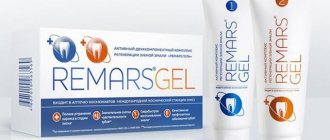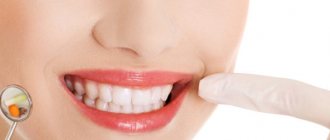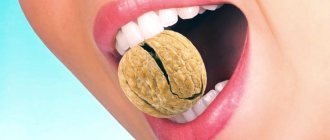Author of the article:
Soldatova Lyudmila Nikolaevna
Candidate of Medical Sciences, Professor of the Department of Clinical Dentistry of the St. Petersburg Medical and Social Institute, Chief Physician of the Alfa-Dent Dental Clinic, St. Petersburg
Enamel is the hardest part of the tooth. This tissue consists of enameloblasts, proteins, lipids and water. Although, at first glance, the enamel has a uniform structure, this is not the case. It varies in thickness in different areas of the teeth. But, unfortunately, even the strongest enamel on teeth can begin to wear off. How to prevent this unpleasant process? Let's try to figure it out.
What is it - erosion of tooth enamel
When dental diseases develop, in most cases it is the enamel, which is the surface of the tooth, that is affected. The more serious the damage, the more dangerous the pathology, since the tooth is left without protection and its functionality is completely impaired.
Tooth erosion is a common disease in which severe thinning of the enamel to dentin occurs. The enamel is destroyed symmetrically on all teeth in the oral cavity with the exception of molars.
The pathological process is accompanied by painful sensations when eating and drinking drinks, brushing teeth and even inhaling cold air. In addition to physiological and functional disorders, there is a serious aesthetic defect. If tooth enamel erosion is not advanced, then therapeutic treatment can give a positive result. However, if the tooth is severely damaged, then it can only be restored using the restoration method.
Ways to restore enamel yourself
The main reason for thinning enamel and its looseness is a lack of fluoride and calcium in the body. Destructive processes are also influenced by factors such as metabolism. With a disturbed metabolism and an incorrect alkaline balance in saliva, the enamel softens and gradually breaks down, opening the way for harmful bacteria.
Is it possible to counter this at home? Yes it is possible. First of all, you need to establish proper nutrition, start taking calcium-containing foods and medications, and also make it a rule to regularly brush your teeth with special toothpastes high in fluoride and calcium. The latter help strengthen the enamel layer at the local level.
However, all these measures can achieve results only if the enamel has not yet begun to deteriorate. At the first signs of caries, it is better to consult a doctor, and use the given home teeth strengthening measures in addition to the prescribed course of treatment.
Causes of the disease
The exact causes of tooth enamel erosion have not been determined. Dentists do not exclude the possibility of developing the disease in every person, even with constant monitoring of oral health.
But there are a number of possible provoking factors.
- Mechanical. The enamel can be damaged by mechanical stress due to excessive pressure on the teeth with a brush with hard bristles, or the use of a whitening paste with large abrasive particles. The surface of the tooth is also often damaged in people who have the habit of gnawing something or opening jars with their teeth, etc.
- Chemical. The highest risk is the chemical factor, which involves excessively frequent consumption of drinks or foods with high acidity.
- Endocrine. The connection between the functioning of the thyroid gland and the condition of tooth enamel has not been determined, but according to research, in patients with hyperthyroidism, tooth erosion occurs much more often.
- Anatomical. In case of malocclusion or the absence of chewing teeth, the distribution of the load on the dentition occurs unevenly, which leads to the abrasion of the enamel on the teeth, onto which all the pressure is redistributed.
- Medication. Some medications also have an impact on the condition of teeth as a side effect.
- Hereditary. Problems with tooth enamel can be genetic and are often inherited.
According to statistics, erosion of tooth enamel is detected mainly in women over the age of 35 years. But pathology is increasingly being diagnosed in children with baby teeth.
Methods for restoring enamel in a clinical setting
All existing professional methods for restoring tooth enamel can be divided into two broad areas:
- application of substances that slow down the processes of destruction and restore tissue by releasing the elements they contain to the tooth;
- replenishment of damaged enamel with a specialized composition.
In case of slight destruction of the enamel, special fluoride varnishes and gels come to the rescue, which the dentist applies to the surface of the tooth using an applicator. It is also possible to install a mouthguard filled with professional varnish. After some time, the mouth guard is removed and re-processed as necessary.
If tooth enamel is severely damaged, varnish alone will not do. A solution that is similar in composition to the structure of enamel helps solve the problem. That’s what they call it – artificial enamel. The substance is implanted inside the affected area, and in the future it provides effective protection of the tooth from further destruction.
If the enamel is completely destroyed, the doctor may recommend veneers, composite plates that are placed over the diseased tooth. Veneers imitate a tooth in a healthy state, providing a beautiful smile, and at the same time protecting the original one from further destruction. They are made individually and can have any shape. The structure of the material is resistant to chemical attack and does not react to acids and alkalis. What you need for a beautiful smile.
How to detect the disease in time
Erosion on the enamel should be treated immediately. The disease can progress very quickly and within a few months completely destroy not only the surface of the tooth, but also the dentin, leaving the pulp exposed.
There are three main stages of pathology.
- First. This is the initial stage, during which it is difficult to independently detect signs of dental damage. During examination, the dentist may detect a loss of shine and a change in the shade of the enamel.
- Second. At the middle stage, more pronounced signs already appear indicating increased sensitivity of the enamel: reaction to food (salty/sweet, hot/cold, spicy, etc.). Pigmentation becomes obvious.
- Third. It is considered a deep and advanced stage. Part of the enamel may be completely missing. Dentin is exposed. Brown or yellow spots are visible on the preserved surface of the tooth.
The disease is also classified according to the nature of its course. There are two forms: active and stable. In the active form, the disease progresses quickly with a characteristic change in the color and structure of the enamel. The stable form is characterized by the absence of symptoms and restoration of enamel using the body’s resources.
Do you need a strengthening diet for teeth?
In everyday life, it is important to adhere to an anti-caries diet. This diet involves limiting the consumption of sweets and, in particular, sugary drinks. The menu should be dominated by solid, granular, even fibrous foods.
A restorative diet for enamel involves increasing the calcium content in the daily menu. If there are no other health contraindications, it is recommended to increase the consumption of milk and dairy products, such as white cheese and natural yogurt.
How is the treatment carried out?
Erosion of enamel can be detected by a dentist during a preventive examination; this most often occurs at the initial stage during regular visits to a specialist, or it can be diagnosed after a patient complains.
If indicated, the dentist may refer you to an endocrinologist or gastroenterologist for consultation. For successful treatment, it is important to correctly identify the provoking factor and draw up an individual plan for complex therapy.
Damaged tooth enamel cannot be restored naturally. If treated in a timely manner, the dentist must take measures to block the process of tooth decay. After treatment is completed, teeth are restored to restore their appearance.
Why do teeth have cracks?
As a rule, the causes of cracks in teeth are explained by a combination of two factors - weakening of the enamel and physical impact on it. Here is a list of the main reasons:
➢
mechanical impact: when teeth gnaw nuts and solid food, open bottles, etc.;
➢
constant use of abrasive pastes and/or frequent bleaching in the clinic;
➢
bruxism;
➢
insufficient oral hygiene;
➢
a sharp change in temperature when hot and cold food is consumed at the same time;
➢
eating large quantities of citrus fruits and other acidic foods;
➢
taking certain antibiotics;
➢
wearing braces;
➢
medical errors;
➢
smoking.
Composite restoration
Restoration with composite materials is carried out in cases of significant damage to the tooth surface and deep caries. Restorative composite is often used to fill canals when removing nerves. The operation consists of multi-layer application of a composite. To give a natural look to molars or incisors, the surface of the tooth must be ground after each layer is applied. Then, after the procedure is completed, the teeth will not look bulky. Each applied layer is dried separately. The results can last for years, and with proper oral care, the service life is more than 10 years. Despite the final result, the composite restoration procedure involves the destruction of the protective layer of the tooth. At its core, restoration seems to be a replacement therapy: natural enamel is not restored, but is replaced with artificial material.
Structure and composition of the dental shell
Contrary to misconceptions, this thin shell of the crown part of our teeth has no color, it is translucent. The shade of teeth is largely given by dentin, that is, the main part. The enamel covers only the upper part, and disappears at the roots. For comparison: in the area of the chewing surface, the thickness of the protective shell reaches 3-3.5 millimeters, and in the cervical area it is almost completely absent - 0.1 mm.
This thin fabric is really very durable, because it contains only a few percent water, some proteins, lipids and carbohydrates, and the rest is inorganic substances. Mainly calcium and phosphorus.
Interesting! The hardest shell of the teeth, unlike other tissues of the body, does not contain cells. This outer layer is lined with crystals that are arranged into bundles - prisms. Here is another reason why enamel cannot regenerate, and cracks in it do not heal over time.
What are the types of cracks in teeth?
There are several ways to diagnose cracks in tooth enamel. Most often, dentists conduct a visual examination through binoculars and use dyes that can reveal even the smallest damage. The doctor may also order an x-ray to identify hidden cracks and determine the depth of tissue damage. Damage to enamel is classified depending on the direction of the cracks.
- Vertical.
- Horizontal.
- Diagonal.
- Multiple.
- Hidden.
The direction and depth of the crack will tell the doctor what the prospects for the development of the disease are and how urgently treatment is required. For example, a shallow crack along a tooth is quite safe and does not always require intervention, although the patient should carefully monitor his condition: if pain appears, the color of the enamel has changed, or sensitivity has increased, treatment will still have to be done. But horizontal and diagonal cracks are much more dangerous: under load, they very quickly lead to tissue destruction. Hidden cracks can only be seen on an x-ray and are the most difficult to treat.
Causes of tooth enamel destruction
Why does tooth enamel, so hard and durable, erode? There are many reasons:
- love of soda, especially sweet carbonated drinks, energy drinks;
- eating large amounts of fruits and fruit juices - despite the benefits of these products, they contain acid, which is very aggressive and leads to the destruction of enamel;
- the predominance of carbohydrates in the diet (sweets, baked goods, starch-containing products);
- disruption of the salivary glands (dry mouth);
- GERD (gastroesophageal reflux disease);
- disturbances in the functioning of the digestive system;
- genetic predisposition;
- disturbance of metabolic processes in the body associated with disruption of the endocrine system;
- smoking;
- natural mechanical wear (chewing loads, friction);
- stress;
- malocclusion;
- lack of essential minerals and vitamins in the diet (and in the body);
- taking certain medications (aspirin, allergy medications, etc.);
- home whitening without supervision and consultation with a dentist, using low-quality preparations;
- using teeth for purposes other than their intended purpose (for cracking nuts and opening bottle caps);
- injuries resulting from impact, road accident;
- eating very cold and very hot foods or a combination of contrasting temperatures (hot tea after ice cream).
Another factor dangerous to enamel is the formation of plaque. In itself, it is not dangerous, but when a sticky film appears on the teeth, it becomes an ideal environment for bacteria to live and multiply. Bacterial waste products contain acids, which cause damage to the integrity of the enamel and the development of caries.
Are cracked teeth dangerous?
If you have a crack in your tooth, the consequences can be very serious, including tooth loss. If enamel fractures are not treated, then over time, under load, they will increase, expand, the enamel will weaken, dentin will be damaged, which will lead to complications.
✔
Teeth with cracks are not protected from external influences, so increased tooth sensitivity, sensitivity to hot, cold, sweet and sour foods progresses. There may be pain when biting.
✔
Food particles, plaque, and bacteria get caught in the cracks, and it is very difficult to clean them out of the cracks. In such a favorable environment, caries develops very quickly, the tooth is gradually destroyed, and pulpitis and periodontitis can occur.
✔
Tooth chips and fractures are a very common complication of cracked enamel. May be accompanied by soft tissue injuries.
✔
Tooth loss is the most unpleasant consequence of cracked teeth. If a tooth is completely cracked and it is not possible to restore it, the doctor decides to remove it, otherwise the risk of pulp infection and soft tissue injury is too great.
✔
Psychological discomfort in cases of cracks in the front teeth.
What does a tooth consist of?
Anatomically, a tooth consists of a root, neck and crown. However, it is correct to consider the tooth as a whole system in which gums, bone tissue, and connective tissue play an important role.
The root of the tooth is located in the alveolus. It is tightly surrounded on all sides by connective tissue, which ensures strong fixation of the tooth in the socket. The neck of the tooth, connecting the root and the coronal part, is surrounded by gum (mucous tissue) and, by analogy with the root, has a strong connection with the jaw bone. The crown is the part of the tooth that is located above the gum and is intended for chewing and articulation.
But we only looked at parts of the tooth, and there is also its histological structure:
- 1
Enamel covers the tooth, is the hardest tissue in the body and protects the teeth from bacteria. Enamel consists of approximately 97% mineral salts and takes on all chemical and mechanical loads. - 2
Dentin is the supporting component of the tooth, which is as hard as bone tissue.
- 3
The pulp is a neurovascular bundle, the main function of which is to provide life support to the tooth (delivery of nutrients and oxygen to the tooth tissues). It is this that is the source of pain when the tooth is deeply damaged by caries.
- 4
Cement – has a composition close to that of bone tissue, a lamellar structure based on collagen fibers and an adhesive substance.
- 5
Alveolus or, in simple words, the hole of the tooth root.
- 6
Periodontium is the tissue surrounding the tooth, connecting the root to the jaw bone, penetrated by blood vessels and nerve endings. Periodontal tissues are responsible for the nutrition and life support of teeth.
Tooth enamel, which is in direct contact with food, acids, bacteria, and foods of different temperatures, is subject to the greatest stress. Therefore, tooth decay begins with damage to the enamel.
Do you know that in Star Smile clinics you can cure caries for free?
A special feature of orthodontic treatment - bite correction using aligners at Star Smile clinics is that we provide you with all the basic preparation for treatment free of charge.
This preparation also includes the treatment of carious teeth. The caries treatment service is a gift from Star Smile to you. After all, all teeth must be absolutely healthy before starting to correct the bite. Don't miss the opportunity to treat your teeth absolutely free. Book a consultation for details.
Remineralization
Restoring tooth enamel using the remineralization method is especially popular in pediatric dentistry. The procedure involves restoring the mineral balance in the tooth structure and treating damaged enamel. Remineralization ideally helps in case of identifying primary signs of thinning enamel and the formation of carious cavities. The clinic offers dental remineralization procedures for children and adults. The manipulation is a complex technical process and should therefore only be carried out in qualified dental offices. The main advantages include:
- prevention of caries;
- the possibility of treating caries in the initial stage of development (whitish spot);
- improving the appearance of the dentition;
- reduction of enamel hypersensitivity;
- lightening teeth several shades;
- restoration of oral microflora.
If caries has reached the deep layers of the tooth, then the remineralization procedure will no longer help. Here it would be appropriate to open the tooth cavity with the subsequent application of filling material.










